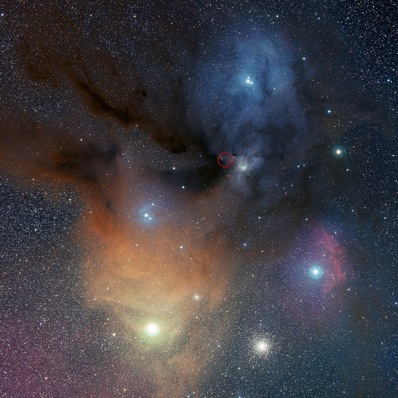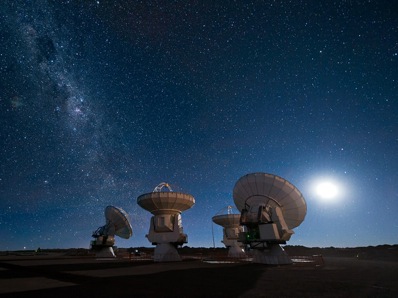
Bleach in space!
GEMMA LAVENDER
ASTRONOMY NOW
Posted: 06 July 2011


An international team of astronomers have made the first ever discovery of hydrogen peroxide in interstellar space, supplying clues of the chemical link between hydrogen and oxygen – two elements that are critical for life and play a key role in the chemistry of water and ozone in our planet's atmosphere.

Rho Ophiuchi's colourful star formation region. Astronomers located the presence of hydrogen peroxide in the region enclosed by the red circle. Rho Ophiuchi is also a good source for amateur observations. Image: ESO/S. Guisard.
The molecular finding, which is familiar in its use as a disinfectant or to bleach hair blonde, was detected with the help of ESO's Atacama Pathfinder Experiment (APEX) telescope, which is situated at a dizzy height of 5,000 metres on the Chajnantor plateau in the Chilean Andes. The team's discovery was the fruits of observing a region in our Galaxy close to the star Rho Ophiuchi, which lies around 400 light-years away.
At a freezing –250 degrees Celsius, dense clouds of cosmic gas and dust in which new stars are born, comprise the region. These clouds are abundant in hydrogen, with bursts of traces of other chemicals, making them prime targets for astronomers in their search for interstellar molecules. Telescopes such as APEX are ideal for detecting signals from these molecules since they are able to make observations of light at millimetre and submillimetre wavelengths.
“We were really excited to discover the signatures of hydrogen peroxide with APEX,” says Per Bergman, an astronomer at Onsala Space Observatory in Sweden, who is also lead author of the study published in Astronomy & Astrophysics. “We knew from laboratory experiments which wavelengths to look for, but the amount of hydrogen peroxide in the cloud is just one molecule for every ten billion hydrogen molecules, so the detection required very careful observations.”

Four of ALMA's antennas gaze up at the night sky. This array could provide clues on the origin of important molecules for life. Image: ESO/José Francisco Salgado.
Since the formation of hydrogen peroxide is believed to be closely linked to the life-assisting molecules, oxygen and water, and since scientists believe that water was originally formed in space, astronomers and chemists alike are keen to understand how the new space molecule was created. One suggestion is that the freshly uncovered molecule is thought to form in space on the surfaces of the grains of cosmic dust – very fine particles similar to the sand and soot that we find here on our home planet – when hydrogen is combined with oxygen molecules. Due to a reaction of adding more hydrogen to the hydrogen peroxide, water is produced, therefore offering clues for astronomers to understand how water formed in the Universe.
“We don't understand yet how some of the most important molecules here on Earth are made in space,” says Berengere Parise, the head of the Emmy Noether research group on star formation and astrochemistry at the Max-Planck Institute for Radio Astronomy in Germany, and a co-author of the paper. “But our discovery of hydrogen peroxide with APEX seems to be showing us that cosmic dust is the missing ingredient in the process.”
More careful observations of Rho Ophiuchi and other star-forming clouds using powerful telescopes such as the Atacama Large Millimetre/submillimetre Array (ALMA), which is scheduled to be in operational mode in 2013, will hopefully present the remaining piece of the jigsaw puzzle of how the origins of these important molecules are intertwined.
|



